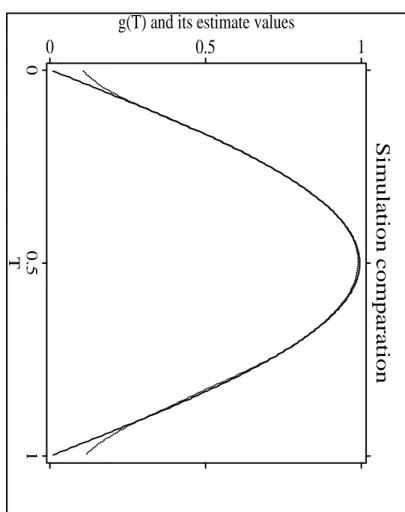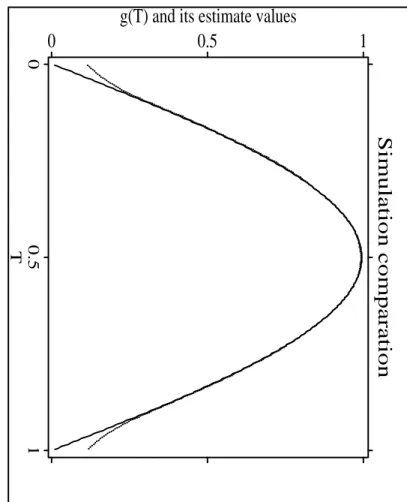ASYMPTOTICNORMALITYOF
PARAMETRICPARTINPARTIAL
LINEARHETEROSCEDASTIC
REGRESSIONMODELS
HuaLiangandWolfgangHardle
AbstractConsiderthepartiallinearheteroscedasticmodelYi=X Ti
+g(Ti)+iei1i nwithrandomvariables(XiTi)andresponsevariablesYiandunknownregressionfunctiong().Weassumethattheerrorsareheteroscedastic,i.e., 2i6=const:eiarei.i.d.randomerrorwithmeanzeroandvariance1.Inthispartiallinearheteroscedasticmodel,weconsiderthesituationsthatthevariancesareanunknownsmoothfunctionofexogenousvariables,orofnonlinearvariablesTi,orofthemeanresponseX Ti
+g(Ti):Undergeneralassumptions,weconstructanestimatoroftheregressionparametervectorwhichisasymptoticallyequivalenttotheweightedleastsquaresestimatoreswithknownvariance.Inprocedureofconstructingtheestimators,thetechniqueofsplittingthesamplesisadopted.
Key W ords and Phrases:
Nonparametricestimation,partiallinearmodel,heteroscedas-tic,semiparametricmodel,asymptoticnormality.Short title:
HeteroscedasticityINTRODUCTIONConsiderthesemiparametricpartiallinearregressionmodel,whichisdenedbyYi=X Ti+g(Ti)+"ii=1:::n(1)HuaLiangisAssociateProfessorofStatistics,atInstituteofSystemsScience,ChineseAcademyofSciences,Beijing100080.WolfgangHardleisProfessorofEconometrics,attheInstitutfurStatistikundOkonometrie,Humboldt-UniversitatzuBerlin,D-10178Berlin,Germany.ThisresearchwassupportedbySonderforschungsbereich373\QuantikationundSimulationOkonomischerProzesse".TherstauthorwassupportedbyAlexandervonHumboldtFoundation.TheauthorswouldliketothankDr.UlrikeGrasshoforhervaluablecomments.1
withXi=(xi1:::xip) TandTi201]randomdesignpoints,=(
1:::p) Ttheun-knownparametervectorandganunknownLipschitzcontinuousfunctionfrom01]toIR.Therandomerrors"
1:::"naremeanzerovariableswithvariance1.ThismodelwasstudiedbyEngle,etal.(1986)undertheassumptionofconstanterrorvariance.Morerecentworkinthissemiparametriccontextdealtwiththeestimationofataroot-nrate.Chen(1988),Heckman(1986),Robinson(1988)andSpeckman(1988)constructed pn;consistentestimatesofundervariousassumptionsonthefunctiongandonthedistributionsof"and(XT).Cuzick(1992a)constructedecientestimatesofwhentheerrordensityisknown.TheproblemwasextendedlatertothecaseofunknownerrordistributionbyCuzick(1992b)andSchick(1993).Schick(1996a,b)consideredtheproblemofheteroscedasticity,i.e.,ofnonconstanterrorvariance,formodel(1).Heconstructedroot-nconsistentweightedleastsquaresestimateswithrandomweightofthenite-dimensionalparameter,andgaveanoptimalweightfunctionwhenthevarianceisknownuptoamultiplicativeconstant.HismodelfornonconstantvariancefunctionofYgiven(XT)assumedthatitissomeunknownsmoothfunctionofanexogenousrandomvectorW,whichisunrelatedwithandg.Thepresentpaperfocustouniformlyexistedapproachesintheliteratureandtoextendsomeofexistingresults.Itisconcernedwiththecasesthat 2iissomefunctionofsomeindependentexogenousvariablesforsomefunctionofTiforsomefunctionofX Ti+g(Ti):Theaimofthispaperistopresentauniformlyapplicablemethodforestimatingthepa-rameterontheregressionmodel(1)withheteroscedasticerror,andthentoprovethatinlargesamplesthereisnocostduetoestimatingthevariancefunctionunderappropriateconditions.Inouranalysisitisrelatedtotheliteratureonattentioninsemiparametricmodels.EarlierpapersareBickel(1978),Carroll(1982),CarrollandRuppert(1982)andMuller,etal.(1987).Therearemainlytwokindoftheoreticalanalysis,thatis,theparametricapproach,whichgenerallyassumed 2i=H(Xi)orH(X Ti)forHbeingknown.SeeBoxandHill(1974),Carroll(1982),CarrollandRuppert(1982),JobsonandFuller(1980)andMak(1992)]andthenonparametricapproach,whichassumed 2i=H(Xi)orH(X Ti)forHbeingunknown.SeeCarrollandHardle(1989),FullerandRao(1978)andHallandCarroll(1989)]
2
Letf(YiXiTi)i=1:::ngdenotearandomsamplefromYi=X Ti+g(Ti)+ieii=1:::n(2)whereXiTiTiarethesameastheseinmodel(1).eiarei.i.d.withmean0andvariance1. 2iaresomefunctionsofothervariables,whosespecicformisdiscussedinlatersections.Theclassicapproachworksasfollows.Assumef(XiTiYi)i=1:::n:gsatisfythemodel(2).LetfWni(t)=Wni(tT
1:::Tn)i=1:::ngbeprobabilityweightfunctionsdependingonlyonthedesignpointsT
1:::Tn:Sinceg(Ti)=E(Yi;X Ti).Letbethe"true"value,andthensupposegn(t)= nX j=1 Wnj(t)(Yj;X Tj) Replacenowg(Ti)bygn(Ti)inmodel(2),wethenobtainleastsquaresestimatorofLS=( f
X
Tf
X
) ;1 fX
Tf
Y
(3)where fX
T=( fX1::: fXn) fXi=Xi; Pnj
=1Wnj(Ti)Xj f
Y
=( eY1::: eYn) T eYi=Yi;nj=1Wnj(Ti)Yj:Whentheerrorsareheteroscedastic,LSismodiedtoaweightedleastsquaresestimatorW= nX
i=1 i fXi fX Ti
;1nX i=1 i fXi eYi (4) forsomeweightii=1:::n.Inourmodel(2)wetakei=1= 2i:Inprincipletheweightsi(or 2i)areunknownandmustbeestimated.Supposefbii=1:::ngbeasequenceofestimatorsof.NaturallyonecantakeWgivenin(4)bysubstitutingbybiasourestimatorof:Inordertodeveloptheasymptotictheory,weusetheideaofsplittingofsample.Letknbetheintegerpartofn=2.b (1)iandb (2)iaretheestimatorsofibasedontherstknsample(X
1T
1Y
1):::(Xk
nTk
nYk
n)andthelatern;knsamples(Xk
n+1Tk
n+1Yk
n+1),:::(XnTnYn)respectively.DenenW= nX
i=1 bi fXi fX Ti
;1kn Xi=1 b (2)i fXi eYi+ nX
i=k
n+1 b (1)i fXi eYi (5) astheestimatorof:Thenextstepistoestablishourconclusion,thatis,toprovethatnWisasymptoticnormal.WeintendtoproveWisasymptoticnormal,andthenprove pn(nW;W)3
convergestozeroinprobability.Somenotationsareintroduced."=("
1:::"n) Te"=(e"
1:::e"n) Te"i="i; Pnj
=1Wnj(Ti)"jgni=g(Ti); Pnk
=1Wnk(Ti)g(Tk) bG=(g(T
1)
bgn(T
1):::g(Tn);bgn(Tn)) Thj(t)=E(xijjTi=t),uij=xij;hj(Ti)fori=1:::nandj=1:::p.Wewillusethefollowingassumptions.
Assumption 1.
sup0t1E(kX
1k 3
jT=t)<1andlimn!11=n Pni
=1iuiu Ti=BandBisapositivedenitematrix.Whereui=(ui1:::uip) T:
Assumption 2.
g()andhj()areallLipschitzcontinuousoforder1.Assumption 3.
WeightfunctionsWni()satisfythefollowing:(i)max1in nX
j=1 Wni(Tj)=O(1)a:s:(ii)max
1ijn Wni(Tj)=O(bn)a:s:bn=n ;2=3(iii)max
1in nX
j=1 Wnj(Ti)I(jTj;Tij>cn)=O(cn)a:s:cn=n ;1=2log ;1n:
Assumption 4.
ThereexistconstantsC1andC
2suchthat0<C
1minin imaxin i<C
2:Wesupposethattheestimatorsbiofisatisfysup
1in jbi;ij=oP(n ;q)q1=4(6)WeshallconstructsuchasestimatorsforseveralkindsofiinSections3-5.Thefollowingtheoremspresentgeneralresultsforparameterestimateofpartiallinearheteroscedasticmodels.
Theorem 1.
UnderAssumptions1-4.Wisanasymptoticallynormalestimatorofi.e.,pn(W;);! LN(0B ;1B
1B ;1)
withB
1=CovfX
1;E(X
1jT
1)g:
Theorem 2.
UnderAssumptions1-4and(6).nWisanasymptoticallyequivalent,i.e.,pn(nW;)and pn(W;)havethesameasymptoticallynormaldistributions.
Remark. 1.1.
Inthecaseofconstanterrorvariance,i.e. 2i 2,Theorem1wasobtainedbymanyauthors.Seeforexample,Speckman(1988)andGaoetal.(1995).Thepointisthatithasnocostneitherfromtheadaptitionnorthesplittingmethod.4Remark. 1.2.
Assumptions1-4arerathergeneralinnature,wewillgiveconcreteexamplesinsection3-5.Remark. 1.3.
Theorem2notonlyassuresthatourestimatorgivenin(5)isasymptoticallyequivalenttotheweightedLSestimatorwithknownweightsbutalsogeneralizetheearlierresultsofrelatedliterature.Theoutlineofthepaperisasfollows.Section2statessomeprelimaryresultsforprovingthemainresults.Sections3-5presentvariousdierentvariancefunctionsandstatethecorrespondingestimates.Section6givesresultsofsimulations.TheproofsofTheorems1and2arepostponedinSection7.SOMELEMMASInthissectionwemakesomepreparationforprovingourmainresults.Lemma2.1providestheboundednessforhj(Ti); Pnk
=1Wnk(Ti)hj(Tk)andg(Ti); Pnk
=1Wnk(Ti)g(Tk).Itsproofisimmediate.Denotehns(Ti)=hs(Ti); Pnk
=1Wnk(Ti)xks,recallthatuij=xij;hj(Ti)andui=(ui1:::uip) T.Thevariablesfuigarealsoindependentidenticallydistributedrandomvectors.
Lemma 2.1.
SupposethatAssumptions2and3(iii)hold.Thenmax
1in Gj(Ti); nX
k=1 Wnk(Ti)Gj(Tk) =O(cn)forj=0:::p
whereG
0()=g()andGl()=hl()forl=1:::p:
Lemma 2.2.
SupposeAssumptions1-3hold.Thenlimn!1 1n nXi=1 i fX Ti
fXi=B
Pro of.
Itfollowsfromxis=hs(Ti)+uisthatthe(sm);thelementof 1n Pni=1i fX TifXi(sm=1:::p)is1n nX i=1 iexisexim= 1n nX
i=1 iuisuim+ 1n nX
i=1 i hns(Ti)uim
+ 1
n nX
i=1 i hnm(Ti)uis+ 1n nX
i=1 i hns(Ti) hnm
(Ti)
def= 1n nX
i=1 iuisuim+ 1n 3
Xq=1 R (q)nsm
5
Assumption1implieslimn!1i Pni
=1 1n uiu Ti=B:Lemma2.1andAssumption4implyR (3)nsm=o(n):ThenCauchy-SchwarzinequalityyieldsR (1)nsm=oP(n)andR (2)nsm=oP(n):Theseargumentsprovethelemma.NextweshallprovearathergeneralresultonstronguniformconvergenceofweightedaveragesinLemma2.3,whichisappliedinthelaterproofsrepeatly.Firstwegiveanexponentialinequlityforboundedindependentrandomvariables,thatis
Beinstein's Inequalit y.
LetV1:::Vnbeindependentrandomvariableswithzeromeansandboundedranges:jVijM:Thenforeach>0P(j nX i=1 Vij>)2exp h
; 2 .n2 nX i=1 varVi+M oi:
Lemma 2.3.
LetV1:::Vnbeindependentrandomvariableswithmeanszeroandnitevariances,i.e.,sup
1jnEjVjj r
C<1(r2):Assume(akiki=1:::n)beasequenceofpositivenumberssuchthatsup
1iknjakijn ;p1forsome0<p
1<1and Pnj
=1aji=O(n p2)forp
2max(02=r;p
1):Thenmax
1in nX
k=1 akiVk =O(n ;slogn)fors=(p1;p2)=2:a:s:
Pro of.
DenoteV 0j=VjI(jVjjn 1=r)andV 00j=Vj;V 0jforj=1:::n:LetM=Cn ;p1n =rand=n ;slogn:ByBeinstein'sinequalityP nmax1in nX
j=1 aji(V 0j;EV 0j) >C
1 o
nX
i=1 P n nX
j=1 aji(V 0j;EV 0j) >C
1 o
2nexp
; C
1n ;2slog 2n2 Pnj
=1a 2jiEV 2j+2n;p1+1=r;slogn 2nexp(;C 2
1Clogn)Cn ;3=2forsomelargeC
1>0:Thelastsecondinequalityfromn
Xj=1 a 2jiEV 2jsupjajij nX
j=1 ajiEV 2j=n ;p1+p2andn ;p1+1=r;slognn ;p1+p2:ByBorel-CantelliLemmamax
1in nX
j=1 Wnj(Ti)(V 0j;EV 0j) =O(n ;slogn)a:s:(7)Let1p<2,1=p+1=q=1suchthat1=q<(p
1+p
2)=2;1=r.ByHolder'sinequalitymax
1in nX
j=1 aji(V 00j;EV 00j) max1in nX
j=1 jajij q
1=qnX j=1 jV 00j;EV 00jj p
1=p
Cn ;(p1q;1)=q nX
j=1 jV 00j;EV 00jj p
1=p(8)
6
Observethat1n nX
j=1
jV 00j;EV 00jj p
;EjV 00j;EV 00jj p
!0a:s:(9)
andEjV 00jj p
EjVjj rn ;1+p=r,andthenn
Xj=1 EjV 00j;EV 00jj p
Cn p=ra:s:(10)
Combining(8),(9)with(10),weobtain
max
1in nX
k=1 aki(V 00k;EV 00k) Cn ;p1+1=q+1=r=o(n ;s)a:s:(11) Lemma2.3followsfrom(7)and(11)directly.Letr=3Vk=ekorukl,aji=Wnj(Ti)p
1= 2
3 andp2=0:Weobtainthefollowingformulas,whichwillplaycriticalrolesintheprocessofprovingthetheorems.maxin nX k=1 Wnk(Ti)ek =O(n ;1=3logn)a:s:(12)
andmaxin nX
k=1 Wnk(Ti)ukl =O(n ;1=3logn)forl=1:::pa:s:
VARIANCEISAFUNCTIONOFOTHERRAN-
DOMVARIABLESThissectionisdevotedtothenonparametricheteroscedasticitystructure 2i=H(Wi)HunknownLipschitzcontinuouswherefWii=1:::ngarealsodesignpoints,whichareassumedtobeindependentofeiand(XiTi)anddenedon01].Dene
cHn(w)= nX
j=1 fWnj(w)(Yj;X TjLS;bgn(Ti)) 2
astheestimatorofH(w).WhereffWnj(t)i=1:::ngisasequenceofweightfunctionssatisfyingalsothesameassumptionsonfWnj(t)j=1:::ng:7
Theorem 3.1.
Underourassumptions,sup1in j cHn(Wi);H(Wi)j=oP(n ;1=3logn)
Pro of.
Set"i=ieifori=1:::n.NotethatcHn(Wi)= nX j=1 fWnj(Wi)(eYj;fX TjLS) 2
= nX
j=1 fWnj(Wi)f fX Tj(;LS)+eg(Ti)+e"ig 2
=(;LS) T nX
j=1 fWnj(Wi) fX Tj(;LS)+ nX
j=1 fWnj(Wi)eg 2(Ti)+ nX
j=1 fWnj(Wi)e"i
+2(;LS) nX
j=1 fWnj(Wi) fX Tj
eg(Ti)+2(;LS) nX j=1 fWnj(Wi) fX Tj
e"i
+2 nX
j=1 fWnj(Wi)eg(Ti)e"i(13) Since Pnj
=1 fXj fX Tjisasymmetricmatrix,and0< fWnj(Wi)Cn ;2=3,n
Xj=1 f fWnj(Wi);Cn ;2=3
g fXj fX Tj
isappnonpositivematrix.RecallthatLS;=O(n ;1=2).Theseargumentsmeanthersttermof(13)isOP(n ;2=3):Thesecondtermof(13)iseasilyshowntobeorderOP(n 1=3c 2n):Nowwewanttoshowthatsupi nX
j=1 fWnj(Wi)e" 2i;H(Wi) =OP(n ;1=3logn)(14)Thisisequivalenttoprovethefollowingthreeitemssupi nX
j=1 fWnj(Wi) nnX
k=1 Wnk(Tj)"k o
2
=OP(n ;1=3logn)(15)
supi nX
j=1 fWnj(Wi)" 2i;H(Wi) =OP(n ;1=3logn)(16)
supi nX
j=1 fWnj(Wi)"j nnX
k=1 Wnk(Tj)"k o=OP(n ;1=3logn)(17) (12)assuresthat(15)holds.LipschitzcontinuityofH()andassumptionsonfWnj()entails(16),i.e.,supi nX
j=1 fWnj(Wi)" 2i;H(Wi) =OP(n ;1=3logn)(18)
8
whoseproofissimilarasthatofLemma2.1.Bytakingaki= fWnk(Wi)H(Wk)andVk=e 2k;1andr=2andp1=2=3andp2=0inLemma2.3,wehavesupi nX
j=1 fWnj(Wi)H(Wj)(e 2j;1) =OP(n ;1=3logn)(19) Acombinationof(19)and(18)means(15).(16)and(15)andCauchy-Schwarzinequalityimply(17).Thusweproved(14).Thelaterthreetermsof(13)arealloforderoP(n ;1=3logn)byCauchy-Schwarzinequalityandtheconclusionsfortherstthreetermsof(13).ThuswecompletetheproofofTheorem3.1.
VARIANCEISAFUNCTIONDESIGNTiInthissectionweconsiderthecaseinwhichwesupposethevariance 2iisafunctionofthedesignpointsTi,i.e. 2i=H(Ti)HunknownLipschitzcontinuousSimilarasinsection3,wedeneourestimatorofH()as
cHn(t)= nX
j=1 fWnj(t)fYj;X TjLS;bgn(Ti)g 2
Theorem 4.1.
Underourassumptions,sup1in j cHn(Ti);H(Ti)j=oP(n ;1=3logn)
Pro of.
TheproofofTheorem4.1issimilartothatofThorem3.1andisomitted.VARIANCEISAFUNCTIONOFTHEMEANHereweconsiderthemodel(2)with 2i=HfX Ti+g(Ti)gHunknownLipschitzcontinuouswhichmeansthatthevarianceisaunknownfunctionofmeanresponse.ArelatedsituationsinlinearandnonlinearmodelsarediscussedbyCarroll(1982),BoxandHill(1974),Bickel
9
(1978),JobsonandFuller(1980)andCarrollandRuppert(1982).Engleetal.(1986),Greenetal.(1985)andWahba(1984)andothersstudiedtheestimatorfortheregessionfunctionX T+g(T).SinceH()isassumedcompletelyunknown,thestandardmethodistogetinformationaboutH()byreplication,i.e.,weconsiderthefollowing"improved"partiallinearhet-eroscedasticmodelYij=X Ti+g(Ti)+ieijj=1:::mii=1:::nHereYijistheresponseofthejthreplicateatthedesignpoint(XiTi),eijarei.i.d.withmean0andvariance1,,g()and(XiTi)arethesameasthatinmodel(2).WewillborrowtheideaofFullerandRao(1978)forlinearheteroscedasticmodeltoconstructanestimateof 2i.Thatis,tocomputepredictedvalueX TiLS+bgn(Ti)bytleastsquaresestimateLSandnonparametricestimatebgn(Ti)tothedata,andresidualsYij;fX TiLS+bgn(Ti)gandestimate
b 2i= 1mi m
i
Xj=1 Yij;fX TiLS+bgn(Ti)g] 2:(20)Wheneachmistaysbounded,FullerandRao(1978)concludedthattheweightedestimatebasedon(20)andtheweightedleastsquaresestimatesbasedonthetrueweightshavedierentlimitingdistributionsresultsfromthefactthatb 2idonotconvergeinprobabilitytothetrue 2i.
Theorem 5.1.
Letmi=ann 2qdef=m(n)forsomesequenceanconvergingtoinnite.Underourassumptions,sup1in jb 2i;HfX Ti+g(Ti)gj=oP(n ;q)q1=4
Pro of.
Weonlyoutlinetheproofofthetheorem.Infactjb 2i;HfX Ti+g(Ti)gj3fX Ti(;LS)g 2+3fg(Ti);gn(Ti)g 2+ 3mi m
i
Xj=1 2i(e 2ij;1)ThersttwoitemsareobviouslyoP(n ;q):Sinceeijarei.i.d.withmeanzeroandvariance1,aftertakingmi=ann 2q Pm
ij=1(e 2ij;1)isequivalentto Pm(n)j=1(e 2
1j;1):UsingthelawoftheiteratedlogarithmandtheboundednessofH()oneknowthat1mi m
i
Xj=1 2i(e 2ij;1)=Ofm(n) ;1=2logm(n)g=oP(n ;q)ThuswederivetheproofofTheorem5.1.10
SIMULATIONWepresentasmallsimulationstudytoexplainthebehaviourofthepreviousresults.Wetookthefollowingmodelwithdierentvariancefunctions.Yi=X Ti+g(Ti)+i"ii=1:::n=300Heref"igarestandardnormalrandomvariables,fXigandfTigarebothofuniformrandomvariableson01]:=(10:75) Tandg(t)=sin(t).Thesimulationnumberforeachsituationis500:Threemodelsforthevariancefunctionsareconsidered.LSEandWLSErepresenttheleastsquaresestimatorandtheweightedleastsquaresestimatorgivenin(3)and(5),re-spectively.
Model1: 2i=T 2i
Model2: 2i=W 3iwhereWiarei.i.d.uniformlydistributedrandomvariables.
Model3: 2i=a1expa2fX Ti+g(Ti)g 2]where(a1a
2)=(1=41=3200):ThismodelismentionedbyCarroll(1982)withouttheitemg(Ti).
TABEL 1: Sim ulation results ( 10
;3)
EstimatorVariance
0=1
1=0:75ModelBiasMSEBiasMSELSE18.6968.729123.4019.1567WLSE14.2302.25921.932.0011LSE212.8827.23125.5958.4213WLSE25.6761.92350.3571.3241LSE35.94.35118.838.521WLSE31.871.7623.942.642Fromtabel1,onecanndthatourestimator(WLSE)isbetterthanLSEinthesenseofbothbiasandMSEforaboveeachmodel.Bytheway,wealsomentionthebehaviouroftheestimatefornonparametricpart,thatisn
Xi=1 ! ni(t)( eYi; fX TinW)
11
Simulation comparation
00.51T
0 0.5 1
g(T) and its estimate values
Figure1:Estimatesofthefunctiong(T)fortherstmodel! ni()areotherweightfunctionswhichalsosatisfytheAssumption3.Inprocedureofsimula-tions,wetakeNadaraya-Watsonweightfunctionwithquartickernel(15=16)(1;u 2) 2I(ju1)anduseCross-Validationcriteriontoselectbandwidth.Figures1,2,3aredevotedtothesimulationresultsofthenonparametricpartsforthemodels1,2,3,respectively.Inthefollowinggures,solid-linesforrealvaluesanddished-linesforourestimatevalues.Theguresindicatethatourestimatorsfornonparametricpartperformalsowellexcepttheneighbourhoodsofthepoints0and1.
7PROOFSOFTHEOREMSFirsttwonotationsareintroduced.
bAn= nX
i=1 bi fXi fX TiAn= nX
i=1 i fXi fX TiForanymatrixS,s(jl)denotesthe(jl)-thelementofS.
Pro ofo fTheorem 1.
ItfollowsfromthedenitionofWthatW;=A ;1n nnX i=1 i fXieg(Ti)+ nX i=1 i fXie"i o12
Simulation comparation
00.51T
0 0.5 1
g(T) and its estimate values
Figure2:Estimatesofthefunctiong(T)forthesecondmodel
Simulation comparation
00.51T
0 0.5 1
g(T) and its estimate values
Figure3:Estimatesofthefunctiong(T)forthethirdmodel
13
Wewillcompletetheproofbythefollowingthreesteps,forj=1:::p(i)H
1j=1= pn Pni
=1iexijeg(Ti)=oP(1)(ii)H
2j=1= pn Pni
=1iexij n
Pnk
=1Wnk(Ti)ek o=oP(1)(iii)H
3=1= pn Pni
=1i fXiei;! LN(0B ;1B
1B ;1):Theproofof(i)ismainlybasedonlemmas2.1and2.3.Denotehnij=hj(Ti)
Pnk
=1Wnk(Ti)hj(Tk):Note
pnH
1j= nX
i=1 iuijgni+ nX
i=1 ihnijgni; nX
i=1 i nX
q=1 Wnq(Ti)uqjgni(21) InLemma2.3wetaker=2Vk=ukl,aji=gnj 1
4 <p
1< 1 3 andp2=1;p1:Thenthersttermof(21)isOP(n ; 2p
1;1
2)=oP(n 1=2)Thesecondtermof(21)canbeeasilyshowntobeorderOP(nc 2n)byusingLemma2.1.Thethirdtermof(21)canbehandledbyusingAbel'sinequalityandlemmas2.1and2.3.Hence
nX
i=1 nX
q=1 iWnq(Ti)uqjgni C
2nmaxin jgnijmaxin nX q=1 Wnq(Ti)uqj =O(n 2=3cnlogn):
Thuswecompletetheproofof(i).Wenowshow(ii),i.e., pnH
2j!0:Noticethat
pnH
2j= nX
i=1 i nnX
k=1 exkjWni(Tk) oei= nX
i=1 i nnX
k=1 ukjWni(Tk) oei+ nX
i=1 i nnX
k=1 hnkjWni(Tk) oei
; nX
i=1 i hnX
k=1 nnXq=1 uqjWnq(Tk) oWni(Tk) iei(22) Theorderofthersttermof(22)isO(n ; 2p
1;1
2logn)bylettingr=2Vk=ek,ali=
Pnk
=1ukjWni(Tk)and 1
4 <p
1< 1 3 andp2=1;p1inLemma2.3.ItfollowsfromLemma2.1and(12)thatthesecondtermof(22)isboundedby
nX
i=1 i nnX
k=1 hnkjWni(Tk) oei nmaxkn nX
i=1 Wni(Tk)ei maxjkn jhnkjj=O(n 2=3cnlogn)a:s:(23)
14
Thesameargumentasthatfor(23)yieldsthatthethridtermof(22)cabbedealtwithas
nX
i=1 i hnX
k=1 nnXq=1 uqjWnq(Tk) oWni(Tk) iei nmaxkn nXi=1 Wni(Tk)ei maxkn kXq=1 uqjWnq(Tj) =O(n 13log 2n)=o(n 1=2)a:s:(24)Acombination(22){(24)entails(ii).FinallythecentrallimittheoremandLemma2.2derivethat1
pn nX
i=1 i fXiei;! LN(0B
1) whichandthefactthatAn!Bimplythat1
pn A
;1n nX
i=1 i fXiei;! LN(0B ;1B
1B ;1):
ThiscompletestheproofofTheorem1.
Pro ofo fTheorem 2.
InordertocompletetheproofofTheorem2,weprovepn(nW;W)=oP(1)Firstwestateafact,whoseproofisimmediatelyderivedby(6)andLemma2.2,1n jban(jl);an(jl)j=oP(n ;q)(25)forjl=1:::p.Thiswillbeusedlaterrepeatly.ItfollowsthatnW;W= 12 nA ;1n(An; bAn) bA ;1n nX i=1 i fXieg(Ti)
+bA ;1n kn
Xi=1 (i;b (2)i)fXieg(Ti)+bA ;1n(An;bAn)bA ;1n nX
i=1 i fXieei
+ bA ;1n kn
Xi=1 (i;b (2)i) fXieei+ bA ;1n nX
i=k
n+1 (i;b (1)i) fXieg(Ti)
+bA ;1n nX
i=k
n+1 (i;b (1)i)fXieei o(26)
ByCauchy-Schwarzinequality,foranyj=1:::p,
nX
i=1 iexijeg(Ti) C pnmaxin jeg(Ti)j nX
i=1 ex 2ij
1=2
15
ThisisoP(n 3=4)bylemmas2.1and2.2.Thuseachelementofthersttermof(26)isoP(n ;1=2)bywatchingthefactthateachelementofA ;1n(An; bAn) bA ;1nisn ;5=4.ThesimilarargumentshowsthateachelementofthesecondandfthtermsisalsooP(n ;1=2).RecallthattheproofsforH
2j=oP(1)andH
3convergestonormaldistribution,weconcludethatthethirdtermof(26)isalsooP(n ;1=2).Thusweseethatthedicultproblemistoshowthatthefourthandthelasttermsof(26)arebothoP(n ;1=2).Sincetheirproofsarethesame,weonlyshowthat,forj=1:::p,
n
bA ;1n kn
Xi=1 (i;b (2)i)fXieei oj =oP(n ;1=2)
orequivalentlyk
n
Xi=1 (i;b (2)i)exijeei=oP(n 1=2)(27) Letfngbeasequencenumbersconvergetozerobutsatisfyn>n ;1=4.Thenforany>0andj=1:::p
P nkn
Xi=1 (i;b (2)i)exijeiI(ji;b (2)ijn)>n 1=2 o
P nmaxin ji;b (2)ijn o
!0(28)
Thelaststepisdueto(6).NextweshalldealwiththetermP nkn
Xi=1 (i;b (2)i)exijeiI(ji;b (2)ijn)>n 1=2 o
byChebyshv'sinequality.Sinceb (2)iisindependentofeifori=1:::kn,wecaneasilycalculateE nkn
Xi=1 (i;b (2)i)exijei o
2
Thisiswhyweusesplittingtechniqnetoestimateibyb (2)iandb (1)i.Infact,
P nkn
Xi=1 (i;b (2)i)exijeiI(ji;b (2)ijn)>n 1=2 o Pkni=1Ef(i;b (2)i)I(ji;b (2)ijn)g 2EkfXik 2Ee 2in 2
C kn
2nn2 !0(29)
16
Thus,by(28)and(29),k
n
Xi=1 (i;b (2)i)exijei=oP(n 1=2)Finally
kn
Xi=1 (i;b (2)i)exij nnX
k=1 Wnk(Ti)ek o
pn kn
Xi=1 fX 2ij
1=2maxin ji;b (2)ijmaxin nX
k=1 Wnk(Ti)ek ThisisoP(n 1=2)byusing(25)and(12)andLemma2.2,whichand(29)entail(27).WecompletetheproofofTheorem2.
REFERENCES
Bickel,P.J.(1978).UsingresidualsrobustlyI:Testsforheteroscedasticity,nonlinearity.AnnalsofStatistics,
6
266-291.Bickel,PeterJ.,Klaasen,ChrisA.J.,Ritov,Ya'acovandWellner,JonA.(1993).Ecientandadaptiveestimationforsemiparametricmodels.TheJohnsHopkinsUniversityPress.Box,G.E.P.andHill,W.J.(1974).Correctinginhomogeneityofvariancewithpowertrans-formationweighting.Technometrics16
,385-389.Carroll,R.J.andHardle,W.(1989).Secondordereectsinsemiparametricweightedleastsquaresregression.Statistics2
,179-186.Carroll,R.J.(1982).Adaptingforheteroscedasticityinlinearmodels,AnnalsofStatistics,10
,1224-1233.Carroll,R.J.andRuppert,D.(1982).Robustestimationinheteroscedasticitylinearmodels,AnnalsofStatistics,10
,429-441.Chen,H.(1988).Convergenceratesforparametriccomponentsinapartlylinearmodel.AnnalsofStatistics,16
,136-146.Cuzick,J.(1992a).Semiparametricadditiveregression.JournaloftheRoyalStatisticalSociety,SeriesB,54
,831-843.Cuzick,J.(1992b).Ecientestimatesinsemiparametricadditiveregressionmodelswithunknownerrordistribution.AnnalsofStatistics,20
,1129-1136.Engle,R.F.,Granger,C.W.J.,Rice,J.andWeiss,A.(1986).Semiparametricestimatesoftherelationbetweenweatherandelectricitysales.JournaloftheAmericanStatisticalAssociation,81
,310-320.17Fuller,W.A.andRao,J.N.K.(1978).Estimationforalinearregressionmodelwithunknowndiagonalcovariancematrix.AnnalsofStatistics,
6
,1149-1158.Green,P.,Jennison,C.andSeheult,A.(1985).Analysisofeldexperimentsbyleastsquaressmoothing.JournaloftheRoyalStatisticalSociety,SeriesB,47
,299-315.Hall,P.andCarroll,R.J.(1989).Variancefunctionestimationinregression:theeectofestimatingthemean.JournaloftheRoyalStatisticalSociety,SeriesB,51
,3-14.Heckman,N.E.(1986).Splinesmoothinginpartlylinearmodels.JournaloftheRoyalStatisticalSociety,SeriesB,48
,244-248.Jobson,J.D.andFuller,W.A.(1980).Leastsquaresestimationwhencovariancematrixandparametervectorarefunctionallyrelated.JournaloftheAmericanStatisticalAssocia-tion,75
,176-181.Mak,T.K.(1992).Estimationofparametersinheteroscedasticlinearmodels.JournaloftheRoyalStatisticalSociety,SeriesB,54
,648-655.Muller,H.G.andStadtmuller,U.(1987).Estimationofheteroscedasticityinregressionanalysis.AnnalsofStatistics,15,
610-625.Robinson,P.W.(1987).Asymptoticallyecientestimationinthepresenceofheteroscedas-ticityofunknownform.Econometrica,55
,875-891.Robinson,P.M.(1988).Root-N-consistentsemiparametricregression.Econometrica,56
,931-954.Schick,A.(1987).Anoteontheconstructionofasymptoticallylinearestimators.JournalofStatisticalPlanning&Inference,16
,89-105.Correction22
,(1989)269-270.Schick,A.(1996a).Weightedleastsquaresestimatesinpartlylinearregressionmodels.Statistics&ProbabilityLetters,27
,281-287.Schick,A.(1996b).Ecientestimatesinlinearandnonlinearregressionwithheteroscedasticerrors.ToappearbyJournalofStatisticalPlanning&Inference.Speckman,P.(1988).Kernelsmoothinginpartiallinearmodels.JournaloftheRoyalStatisticalSociety,SeriesB,50
,413-436.Wahba,G.(1984).Partialsplinemodelsforthesemi-parametricestimationofseveralvari-ables.InStatisticalAnalysisofTimeSeries,319-329.18

